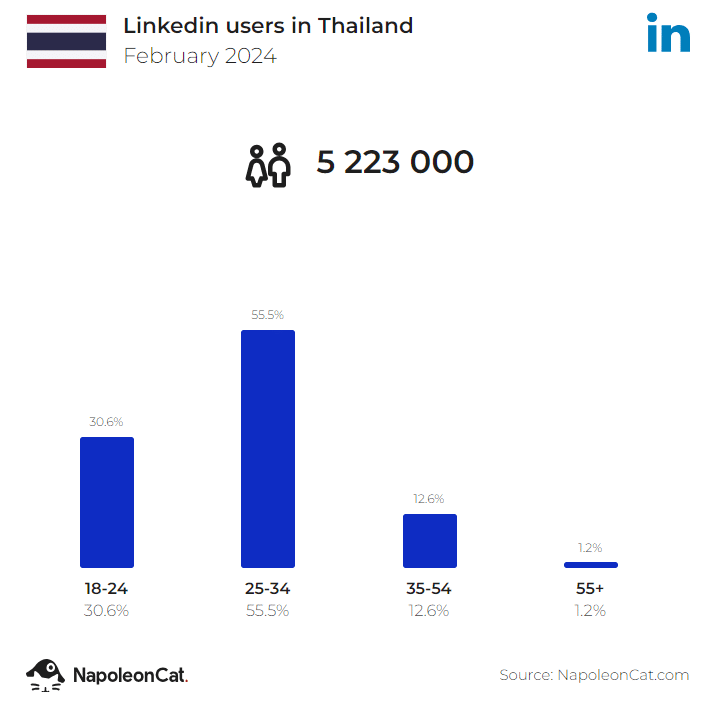Of course, it does. When seeking to hire senior executives for your management positions, it’s important to understand that you are fishing in a limited pool of senior talent on LinkedIn.
Fresh research from February 2024 (time of writing this blog) by NapoleonCat has unveiled some fascinating insights:
- There were 5,223,000 LinkedIn users in Thailand, which accounts for 7% of its entire population.
- People aged 18 up to 34 were the largest LinkedIn user group (4,500,000) and represent 86% of all members in Thailand.
- Just 1% of the 5+ million users are 55 years or older.
- There are 58 million users in Thailand on Facebook and 19 million on Instagram.

The data from NapoleonCat is sourced directly from the respective social platforms’ marketing APIs and compiled for informational purposes only.
NapoleonCAT is a cloud-based social media engagement and content publishing platform for businesses and marketing agencies.
How many check their LinkedIn daily?
Just 16% of LinkedIn users are Active Daily according to The Social Shepherd.
You too have probably come across many LinkedIn profiles that appear to be ghost profiles.
Ghost as in profiles with no photograph, with no background image, no activities, and with a number of connections that are insignificant (below 50-100).
Trying to connect with such profiles usually leads to nowhere.
If you like to reach out to such a person, give them a call at the company where they work – if the workplace is still current.
What is the age of people in management?
 The age of employees working in top management roles can vary significantly depending on various factors such as industry, company size, individual career trajectories, and cultural norms.
The age of employees working in top management roles can vary significantly depending on various factors such as industry, company size, individual career trajectories, and cultural norms.
However, there are some general trends and expectations:
Top Management: Employees typically reach top management positions, such as C-suite roles (CEO, CFO, COO, etc.), in their late 30s to 50s, depending on their career progression, industry norms, and organizational structure.
Mid-Career: By their late 20s to mid-30s, some professionals may start transitioning into mid-level management positions as they accumulate experience, demonstrate leadership potential, and develop specialized expertise within their fields.
Early Career: It’s not uncommon for individuals to enter entry-level positions in their early to mid-20s after completing their education. During this phase, they gain experience and skills that prepare them for higher-level roles.
Experience vs. Youth: While top management roles often require significant experience and expertise, there is also a growing trend of younger individuals assuming leadership positions, particularly in technology-driven industries and startups.
These younger leaders often bring innovative thinking, digital fluency, and a fresh perspective to executive roles.
Continued Growth and Development: Regardless of age, successful top managers continue to grow, adapt, and develop throughout their careers.
Continuous learning, networking, and staying abreast of industry trends are essential for maintaining effectiveness in leadership roles – whatever your age.
Job search tips for babyboomers
 Many decades in the workforce that started at a time when telex was the latest technology when communicating with customers and suppliers across borders.
Many decades in the workforce that started at a time when telex was the latest technology when communicating with customers and suppliers across borders.
We had no laptops or hand-held devices and obviously no internet.
Direct mail campaigns were not electronic mail but a flyer in an envelope delivered by hand through the postal services.
It does not matter whether you are 43 or 63 years old; a key point for any resume is to focus on the last 10 and max 15 years of experience.
Continue to read the separate blog article on how to age-proof your resume. Read it here.

